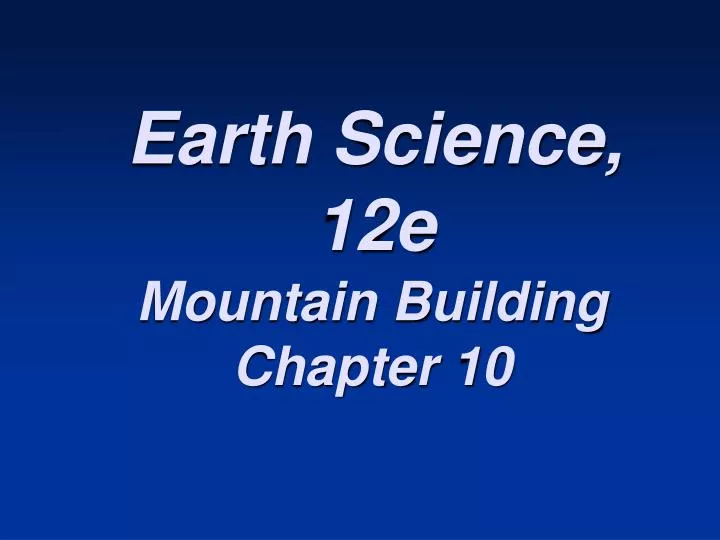Earth Science Ch. 20 Mountain Building Reading Activity
![]() Download
Download

Skip this Video
Loading SlideShow in 5 Seconds..
Earth Science, 12e PowerPoint Presentation


Earth Science, 12e
Download Presentation
Earth Science, 12e
- - - - - - - - - - - - - - - - - - - - - - - - - - - E N D - - - - - - - - - - - - - - - - - - - - - - - - - - -
Presentation Transcript
-
Globe Science, 12e Mountain BuildingChapter x
-
Deformation • Deformationis a full general term that refers to all changes in the original form and/or size of a rock trunk • Most crustal deformation occurs along plate margins • Factors that influence the strength of a rock • Temperature and confining pressure • Rock type • Time
-
Folds • Rocks bent into a series of waves • Most folds event from compressional forces that shorten and thicken the crust • Types of folds • Anticline – upfolded, or biconvex, stone layers • Syncline– downfolded rock layers
-
Folds • Types of folds • Anticlines and synclines can be • Symmetrical – limbs are mirror images • Asymmetrical – limbs are not mirror images • Overturned – ane limb is tilted beyond the vertical • Where folds dice out they are said to be plunging
-
A series of anticlines and synclines Figure 10.3
-
Plunging folds Figure 10.4 A
-
Outcrop patterns of plunging folds Figure 10.4 B
-
Folds • Types of folds • Other types of folds • Dome • Circular, or slightly elongated • Upwarped displacement of rocks • Oldest rocks in core • Basin • Round, or slightly elongated • Downwarped displacement of rocks • Youngest rocks in core
-
The Black Hills of Due south Dakota are a large dome Effigy 10.6
-
The bedrock geology of the Michigan Basin Figure 10.7
-
Faults • Faultsare fractures (breaks) in rocks forth which appreciable displacement has taken place • Types of faults • Dip-slip fault • Movement along the inclination (dip) of fault plane • Parts of a dip-skid fault • Hanging wall – the rock higher up the mistake surface • Footwall – the rock below the error surface
-
Concept of hanging wall and footwall along a fault
-
Faults • Types of faults • Dip-sideslip fault • Types of dip-sideslip faults • Normal fault • Hanging wall block moves downward • Associated with fault-block mountains • Prevalent at spreading centers • Caused past tensional forces
-
A normal fault Figure 10.ix A
-
Error block mountains produced by normal faulting Figure 10.10
-
Faults • Types of faults • Dip-slip fault • Types of dip-slip faults • Reverseandthrust faults • Hanging wall cake moves up • Caused by potent compressional stresses • Reverse fault - dips greater than 45º • Thrust fault - dips less than 45º
-
A reverse fault Figure 10.9 B
-
A thrust error Effigy 10.9 C
-
Faults • Types of faults • Strike-slip faults • Dominant displacement is horizontal and parallel to the trend, or strike • Transform error • Large strike-slip error that cuts through the lithosphere • Oft associated with plate boundaries
-
A strike-slip fault Figure 10.nine D
-
Faults • Types of faults • Joints • Fractures forth which no appreciable displacement has occurred • Most are formed when rocks in the outermost crust are deformed
-
Mountain belts • Orogenesis refers to processes that collectively produce the "classic" mountain belt • Orogeny e'er begins with Subduction • Mount building at convergent boundaries • Most mountain building occurs at convergent plate boundaries
-
Mount belts • Mountain building at convergent boundaries • Passive margins • Prior to the germination of a subduction zone • e.k., East Declension of Due north America • Passive margin evolves into convergent boundary
-
Mountain belts • Mountain edifice at convergent boundaries • Andean-type mount building • Types related to the overriding plate • Active continental margins • Subduction zone forms • Deformation process begins • Continental volcanic arc forms • Accretionary wedge forms • Examples of inactive Andean-type orogenic belts include Sierra Nevada Range and California'southward Coast Ranges
-
Orogenesis along an Andean-type subduction zone Figure 10.15 B
-
Orogenesis along an Andean-blazon subduction zone Effigy 10.xv C
-
Mountain belts • Mount edifice at convergent boundaries • Continental collisions • Where two plates with continental crust converge • e.grand., India and Eurasian plate collision • Himalayan Mountains and the Tibetan Plateau
-
Formation of the Himalayas Effigy 10.xix A
-
Germination of the Himalayas Figure 10.19 B
-
Mount belts • Mountain building at convergent boundaries • Continental accretion • 3rd mechanism of mountain building • Small crustal fragments collide with and accrete to continental margins • Accreted crustal blocks are called terranes • Occurred forth the Pacific Declension
-
Distribution of modern-day oceanic plateaus and fragments Figure 10.xvi
-
Accreted terranes along the western margin of North America Figure 10.xviii
-
Mountain belts • Buoyancy and the principle of isostasy • Bear witness for crustal uplift includes wave-cutting platforms loftier above bounding main level • Reasons for crustal uplift • Not and so piece of cake to determine • Isostasy • Concept of a floating chaff in gravitational balance • When weight is removed from the crust, crustal uplifting occurs • Procedure is called isostatic adjustment
-
The principle of isostasy Effigy ten.23
-
Erosion and resulting isostatic aligning of the crust Figure ten.24 AB
-
Erosion and resulting isostatic adjustment of the crust Figure 10.24 BC
-
End of Chapter x
musgravewastaiden94.blogspot.com
Source: https://www.slideserve.com/nili/earth-science-12e
0 Response to "Earth Science Ch. 20 Mountain Building Reading Activity"
Post a Comment